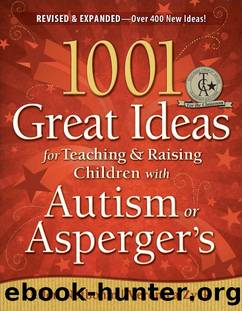1001 Great Ideas for Teaching and Raising Children with Autism Spectrum Disorders by Veronica Zysk & Veronica Zysk

Author:Veronica Zysk & Veronica Zysk [Notbohm, Ellen]
Language: eng
Format: epub
ISBN: 978-1935274-26-1
Publisher: Future Horizons
Published: 2010-06-14T16:00:00+00:00
Moving to a new environment
New house or apartment, new school and/or a new town—such enormous changes can present a towering challenge to the child with autism. But there are many things you can do to ease the transition.
First and most important: take your child’s needs into consideration when choosing the home. If he is noise sensitive, don’t locate near a subway, stadium, concert venue, raceway, factory, etc. Stand in all parts of the home and the yard and listen carefully. Noise can carry for several miles under certain weather conditions, and what may not be immediately noticeable to you may be unbearable for him. Does your child’s behavior erupt frequently? Choose that apartment carefully—ground floor, end unit.
Be sensitive as to how you phrase your descriptions of the move. If the term “new house” seems to trouble him, call it another house, a blue house, our next house. Same goes for all the other “new” things that will happen.
Assure him, in a manner he understands, that all family members, not just him, are making the move and that all of his stuff is going with him—unlike vacation, where he leaves some things behind. Also, be clear that neighbors and friends will not be coming along.
Knowledge is power. The more he knows about his next home or school, the more familiar it will seem to him. Reporters think in terms of the five “W” questions: what, when, where, who, and why (with “how” thrown in for good measure). News stories are constructed in pyramid fashion, with the broadest and most important information coming first. More and more detail is added as the reader or listener’s attention allows. This is a good way to think of presenting information about the move to your child. He can then acclimate to the information at his own pace and not become overwhelmed by new facts, ideas, rules, and decisions.
As your child gains more facts, help him make up or write a story comparing and contrasting the differences between the environment you are leaving and the one to which you are going: these things about my family will be the same, and these things will be different. Emphasize what’s in it for him at the new location. Does the new town have an aquarium, a state-of-the-art movie theatre or library, a public swimming pool nearby? Does the new house have a bigger yard, a sidewalk for riding his scooter, an eating bar in the kitchen, a cool fireplace for roasting marshmallows?
Take photographs of the house from as many angles as possible, and do drive-bys, if possible. After the previous owners have moved, include photos of the interior and the back yard. (Photos depicting previous owners’ belongings may be confusing or set up false expectations.)
Will your child have his own room, and will you allow him to choose new accoutrements such as carpet or paint? Providing carpet square samples and paint chips from which to choose gives him some control over his new environment. (Give him only samples and colors that are within your budget and your willingness to execute.
Download
This site does not store any files on its server. We only index and link to content provided by other sites. Please contact the content providers to delete copyright contents if any and email us, we'll remove relevant links or contents immediately.
| Behavioral Disorders | Communicative Disorders |
| Gifted Students | Inclusive Education |
| Learning Disabled | Mentally Disabled |
| Physically Disabled |
The Art of Coaching Workbook by Elena Aguilar(48390)
Trainspotting by Irvine Welsh(20100)
Twilight of the Idols With the Antichrist and Ecce Homo by Friedrich Nietzsche(17729)
Fangirl by Rainbow Rowell(7857)
Periodization Training for Sports by Tudor Bompa(7349)
Change Your Questions, Change Your Life by Marilee Adams(6676)
This Is How You Lose Her by Junot Diaz(5812)
Grit by Angela Duckworth(4755)
Red Sparrow by Jason Matthews(4699)
Asking the Right Questions: A Guide to Critical Thinking by M. Neil Browne & Stuart M. Keeley(4613)
Paper Towns by Green John(4185)
Room 212 by Kate Stewart(4127)
Ken Follett - World without end by Ken Follett(3986)
The Sports Rules Book by Human Kinetics(3606)
Housekeeping by Marilynne Robinson(3431)
The Motorcycle Diaries by Ernesto Che Guevara(3354)
Introduction to Kinesiology by Shirl J. Hoffman(3312)
Exercise Technique Manual for Resistance Training by National Strength & Conditioning Association(3311)
Double Down (Diary of a Wimpy Kid Book 11) by Jeff Kinney(3293)
